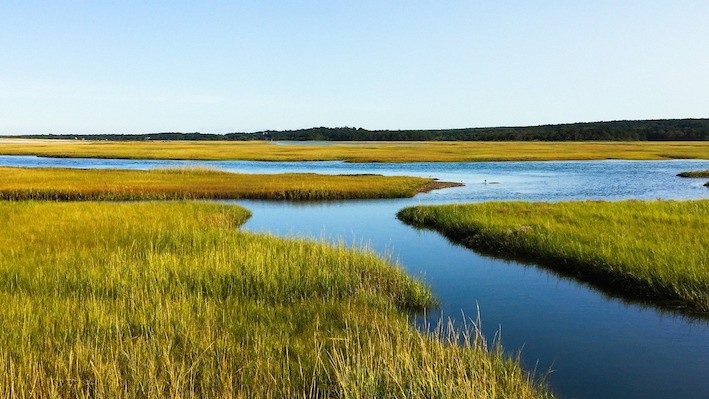Featured image by Jennifer Crowder from Pixabay.
Paper: Enhanced, climate-driven sedimentation on salt marshes
Authors: D.M. FitzGerald, Z.J. Hughes, I.Y. Georgiou, S. Black, A. Novak
Journal: Geophysical Research Letters
We depend on salt marshes to buffer coastal regions from flooding, host unique ecosystems, and store CO2. But marshes could drown if they don’t accumulate sediment fast enough to increase their elevation in step with rising sea levels. To make matters worse, river diversions and dams have reduced the amount of sediment delivered to coastlines, cutting off a key source of salt marsh building material.
However, there may be a previously underappreciated ray of hope. During intense winter storms, chunks of ice with sediment frozen onto them can deposit on salt marshes—a process known as ice rafting. Ice rafting occurs when ice freezes to the bottom of a body of water during low tide, then goes on the move during high tides or storms carrying the sediment still frozen to its base. Previously, geologists thought that sediment delivery to marshes by ice rafting was relatively insignificant. A new study suggests otherwise, and argues that an increase in ice rafting events due to climate change might help salt marshes keep up with sea level rise.
FitzGerald and colleagues used high-resolution aerial photography and field measurements of sediment thickness to document the sediment accumulation due to ice rafting during a single storm along the coast of Massachusetts in January 2018.
The authors found that ice-rafted sediment was deposited over about 140 acres—100 or so football fields—of salt marsh. They measured accumulated sediment thicknesses ranging from five to 10 cm over this area, meaning that ice rafts dumped about seven Olympic swimming pools’ worth of sediment onto the marsh during a single storm. When compared to average rates of marsh accumulation, the ice raft deposits represent 15 years of sediment delivery. That’s good news for marshes that need to keep up with rising seas.
Ice-rafted sediment comes from wherever the ice forms. In this case, those sediment sources are the tidal flats, bays, and channels adjacent to the marsh. This could mean that ice rafts just move sediment around locally, rather than actually helping to build up the marsh on average.
The authors suggest a different interpretation: that ice rafting may be the key final step in the coastal sediment conveyor belt. Ocean and river sediments deposit in the bays and tidal flats, and ice-rafting then delivers that sediment to the salt marshes where it is urgently needed to keep marsh vegetation above sea level. During the 2018 storm, ice rafting delivered sediment to the areas of the marsh that are too far from open water to receive sediment during normal flow events. Storm-driven ice rafting may be critical for keeping these parts of the marsh above the water.
What will happen to ice rafting of sediment under a changing climate? Ice rafting happens in high northern latitudes when cold temperatures and low tides precede large storms. The authors argue that such conditions might be more common as the strength and frequency of winter storms increases due to climate change. If this is true, marsh sedimentation by ice rafting could help prolong the life of northern salt marshes even as sea level rises.

Sediment riding on ice to the rescue of vulnerable salt marshes by Charlie Shobe is licensed under a Creative Commons Attribution 4.0 International License.

